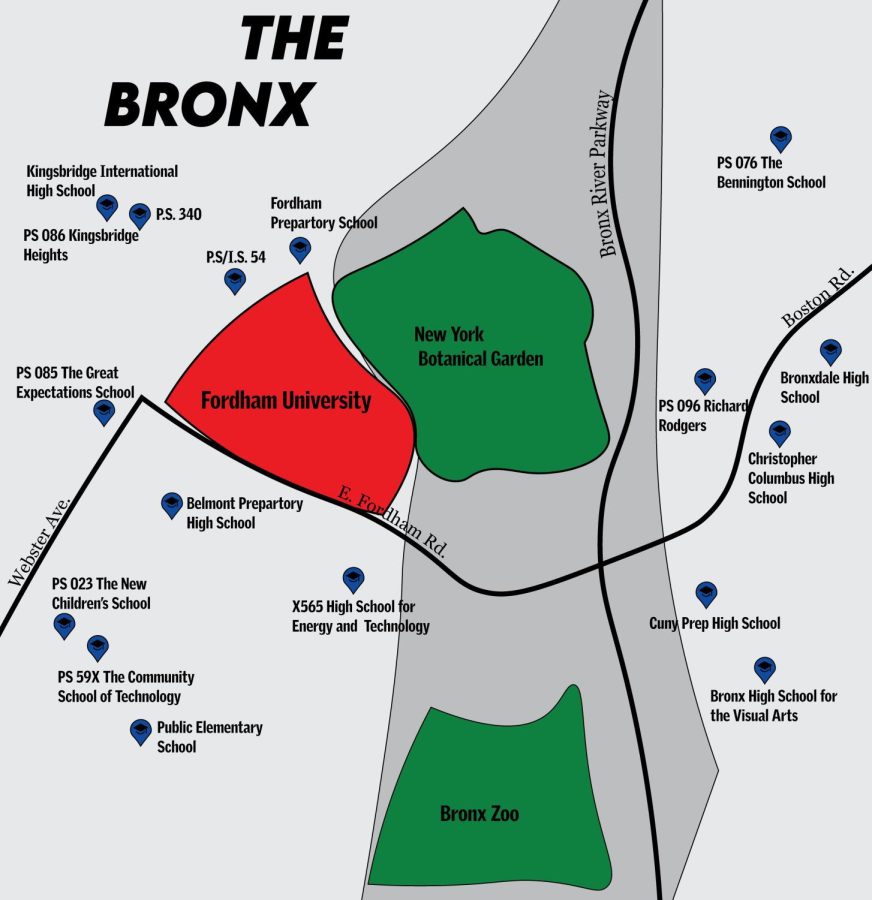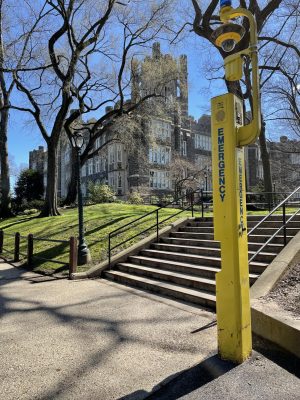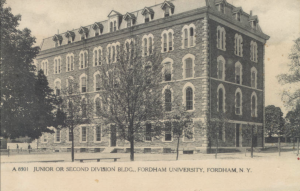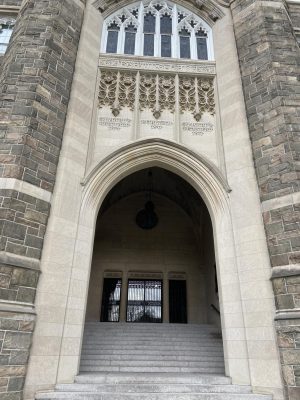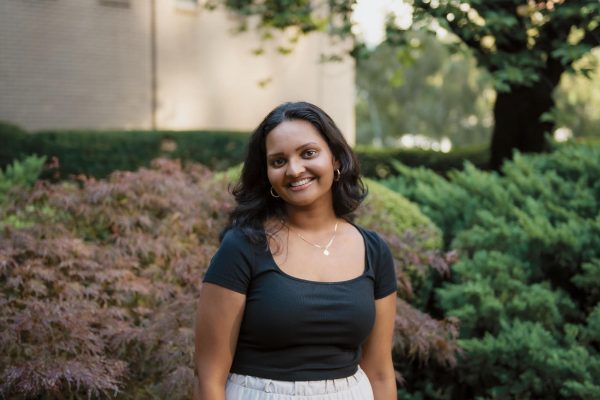University Works To Accept More Students From the Bronx
Community members weigh in on the university’s attempts to attract, admit and retain students from surrounding public and charter schools
Fordham is actively engaged in recruiting local students from the Bronx and admitted 46% of Bronx applicants for the Class of 2025.
April 27, 2022
Fordham University’s flagship campus — Fordham Rose Hill, located on East Fordham Road in the western Bronx — is surrounded by a number of public and charter schools. The university has collaborated with programs to increase the admission and retention rates of these Bronx students.
According to Patricia Peek, dean of undergraduate admissions and assistant vice president, the Office of Admissions is actively engaged in recruiting local students from New York City, with a specific emphasis on students from the Bronx. These efforts include designating an admissions counselor, Cesar Lopez, as the liaison between the Office of Admissions and schools in the borough.
The Office of Admissions also conducts virtual and in-person high school visits, offers virtual and in-person college fairs, and partners with the Higher Education Opportunity Program (HEOP) and the Collegiate Science and Technology Entry Program (CSTEP) to recruit and attract students from the Bronx. Additionally, Peek emphasized that Fordham offers additional financial aid support to admitted students from a subset of local public and private schools.
“We are hoping to continue this positive trajectory and increase Bronx public high school student representation in the current and future classes.” Patricia Peek, dean of undergraduate admissions
For the Class of 2025, the university received more than 1,300 applications from students who attended public schools in the Bronx. Of the 1,300 students, 46% of the applicants, 600 students, were admitted to Fordham, which was an 80% increase from the previous year’s admission rate of 332 students from an applicant pool of the same size. The applicant pool from the Bronx for the Class of 2026 also numbered 1,300 students, but the offer of admission increased to 630 students.
“We enrolled 69% more students from Bronx public schools for the Class of 2025 (90 FCRH students) than in the previous year Fall 2020 (53 enrolled FCRH students),” Peek said about Fordham College at Rose Hill (FCRH)’s Class of 2025. “We are hoping to continue this positive trajectory and increase Bronx public high school student representation in the current and future classes.”
Johanna Quinn, assistant professor of sociology at FCRH, said there is always room for improvement in regard to admitting and uplifting students from surrounding Bronx public schools. She holds the university in high regard for its recent admission and retention rates and emphasized that the university has made substantial progress in recruiting and retaining students from surrounding public schools.
“My mom was talking about how it’s a prestigious school, and it’s good for education, but I’ve also heard that in regards to diversity, it’s not really up there.” Stephanie Ortiz, FCRH ’24
“I think Fordham’s made good inroads in the past two years,” she said. “I think more partnerships and more connections between students and faculty at Fordham and those schools would help students to think of Fordham as a place they should be applying and wanting to attend, and making them come to cultivate and hold onto those relationships would be great for those students and for Fordham.”
Growing up, Stephanie Ortiz, FCRH ’24 and a Bronx native, perceived Fordham as a good university.
“My mom was talking about how it’s a prestigious school, and it’s good for education, but I’ve also heard that in regards to diversity, it’s not really up there,” she said.
For Ortiz, the application process entailed attending a college fair and a meeting with her guidance counselor, who explained that she was eligible for HEOP. She described the college application and admissions process as fairly straightforward.
To improve admission and retention rates, Ortiz recommended that the university contact prospective students via email, conduct on-campus tours, reach out to more public and charter schools, and ensure that students are aware of the financial aid services at their disposal.
Emely Paulino Cuevas, FCRH ’23 and a Bronx native who attended a charter school in a neighborhood near Fordham Rose Hill, explained that if it weren’t for her admission to Fordham and her high school graduation ceremony that was held on the Rose Hill campus, she would never have stepped foot on Fordham’s campus.
“The first time I stepped foot on Fordham University was when I got accepted, and that was the first time ever — and I grew up here,” she said.
Paulino Cuevas also described memories in which she would see students leaving for spring break on the Metro-North, leading her to believe that Fordham was mainly a university for international or out-of-state students.
“I didn’t know that their school was open to accepting people from the Bronx.” Emely Paulino Cuevas, FCRH ’23
“I thought it was very hard to get into one of the top schools,” she said. “I didn’t know that their school was open to accepting people from the Bronx.”
The majority of Fordham students from the Bronx that Paulino Cuevas has met are enrolled in HEOP or CSTEP. While she feels the university has made efforts in accepting more students from the area, she wishes there was a greater acceptance of Bronx residents and applicants from underfunded schools due to Fordham’s roots in the Bronx.
“I wish that there was more help for the Bronx high school students, especially first-generation students, who are from families that never went to college or even high school,” she said.
Despite the areas of improvement, Paulino Cuevas believes Fordham’s performance in terms of recruiting, admitting and supporting students from surrounding public schools is satisfactory.
“I think they’re okay,” she said. “I don’t think they’re doing a bad job, because there are a lot of people that come from charter and public schools that are still in Fordham, and they seem to really like it, and they’re still there.”
For the Class of 2025, the racial demographics of enrolled students from Bronx public high schools are 27% Asian or Pacific Islander, whereas the Bronx is 4.6%; 21% Black or African American, whereas the Bronx is 43.6%; 42% Hispanic, whereas the Bronx is 56.4%; 8% white, whereas the Bronx is 9%; 1% two or more races; and 1% unknown.
Jane Bolgatz, associate professor of curriculum and teaching at the Graduate School of Education, highlighted the importance of implementing financial support services and programs such as CSTEP in order to recruit and retain students from surrounding public schools in the Bronx. Bolgatz emphasized the necessity of ensuring that professors are creating an inclusive and supportive environment for their students
“Don’t just say you’re inclusive — do something about it.” Emely Paulino Cuevas
She also stressed the importance of workshops and training for faculty on racial sensitivity, as well as racial and socioeconomic microaggressions. She underlined the importance of combating stereotype threat, a psychological risk that arises when an individual of a minority group is engaging in an activity to which negative stereotypes of their group apply.
“(Fordham should) have training for all the folks who are supposed to be supportive, make it so that teachers aren’t scared to talk about race and racism and address microaggressions when they happen in the community,” she said. “There’s stereotypes in our society about Black and brown people and academic achievement. Unless you mitigate that stereotype threat, that’s what’s going to happen.”
In terms of methods of improvement, Paulino Cuevas encouraged the university to be more inclusive of candidates and students from diverse backgrounds and to invite residents in the surrounding communities to the campus by arranging activities on weekends and offering programs for the community to participate in.
“Don’t just say you’re inclusive — do something about it,” Paulino Cuevas said.

